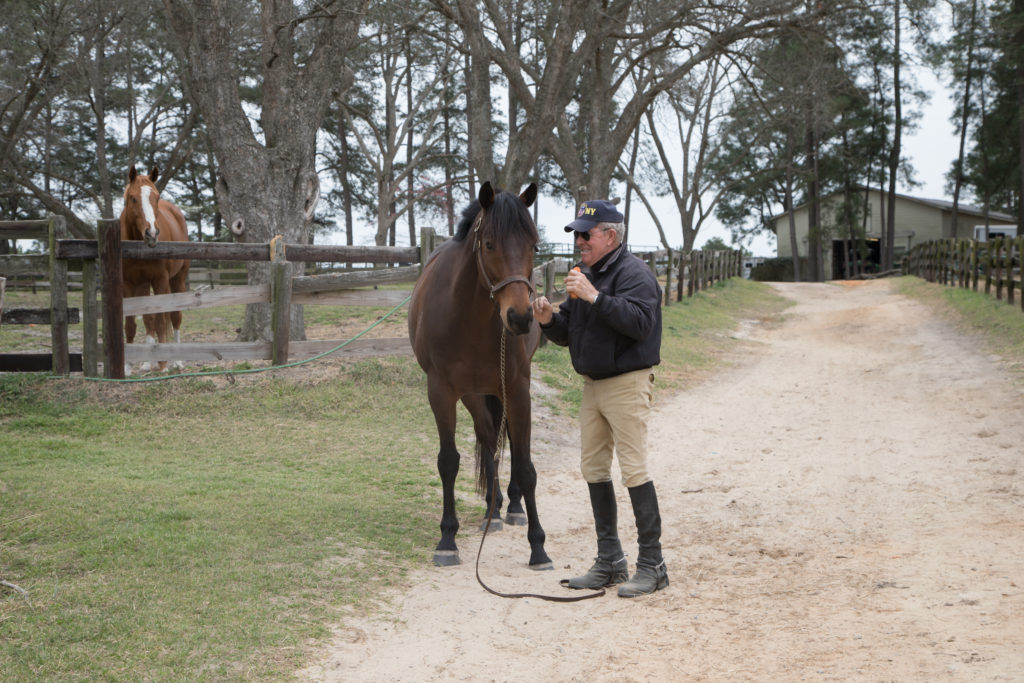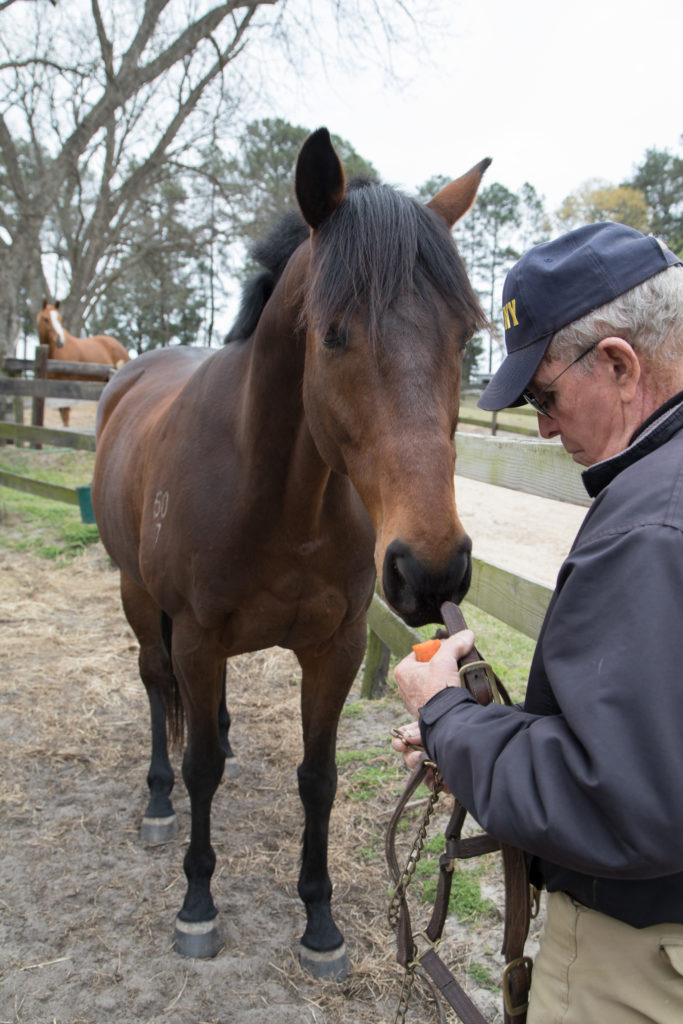 In equestrian circles, J. Michael Plumb is well-known for his success in both team and individual eventing, capturing bronze, silver, and gold medals in the Olympics on a ride that lasted from 1959 to 1992. He was also the first equestrian inducted into the U.S. Olympic Hall of Fame.
In equestrian circles, J. Michael Plumb is well-known for his success in both team and individual eventing, capturing bronze, silver, and gold medals in the Olympics on a ride that lasted from 1959 to 1992. He was also the first equestrian inducted into the U.S. Olympic Hall of Fame.
Plumb, 77, is still dedicated to horses and riders, making his home, stables and training facilities amid towering longleaf pines off May Street in Southern Pines’ horse country at JMP Farm.
A Long Island native and the grandson and son of horsemen, Plumb has carried on the family tradition, excelling as both a rider and trainer, before settling in North Carolina.
Inside the JMP Farm barn office, the dark wooden walls layered with tack—bits, bridles, halters, reins—Plumb discusses staying in the saddle and providing skills to students of all ages.
ONC: Tell us about your JMP Farm.
JMP: I bought this place in 1999. I have 10 acres here, and I run a boarding stable. I teach people. I train horses; that’s what I do. Prior to that, I was involved in the Olympic games, and I was lucky enough to make my living while I was allowed to be an amateur training horse. So, that’s what I have done all my life … train horses.
What do you enjoy most about training?
I enjoy horses. I like being around them. I like trying to figure out how I can make them understand what I want to do, and I am finding that I have to be part of their brains, figuring out how to be friends with them. It sounds a little corny, but it really makes a lot of sense by being able to set the rules but also have them be a part of it. It’s the only way it’s going to work out between me and the horses, and it also works with the kids and grown-ups, of which I work with all ages right now from ages 12 to 71.
What’s an average day on the farm for you?
It takes me from the beginning of the day from 6 o’clock in the morning until the schoolteacher I train arrives around 5:30 to ride here. So, it’s an all-day thing. It can be a challenge, but teaching and training are my focus.
Is there a secret to your longevity with horses and staying active?
I have my health, which is pretty good. I am glad to have it. I can still ride. I have to be careful because I know that if I get hurt, I can’t do a big part of my job, which is to get on. I am lucky that way because I can get on and ride and show people how to do what I am telling them to do, rather than just be on the ground telling them what to do. I am going to lose that pretty soon, although I don’t feel like it. So, that gets me in trouble, because sometimes, I think young, but the body doesn’t always correspond to the mind. So, I have to be very careful about that. I have had plenty of falls, and a lot of them right there out in the ring, doing almost nothing, but I’ve become a little cautious. My instinct is to be a little impetuous, and I have to be careful about that. My britches get a little overblown, my ego gets big, and the horses always let me know and put me in my place.
 Is there a favorite kind of horse that you prefer?
Is there a favorite kind of horse that you prefer?
No, not really. I have to figure out how I am going to get along with them, how I can get my message across to them, and how I can get my message across to the people I am training. It’s very difficult to teach, but it’s easy to ride. I never really gave it a lot of thought. Now, I really have to give it a lot of thought, because I have to explain it to other people how to do it.
You said that you have one horse that is yours?
Yes. A lady in town here a couple of years ago bought 40 horses from an outfit in New Zealand who sent the horses to a Hong Kong racetrack. She bought 40 of them, turns them out in New Hampshire somehow, and they were for sale. And so she brought some down here, and I bought one. He has a brand on every side of him. It’s taken quite a long time and it’s the only one that I have. I about have him broke on my terms. So now, I have to probably show him a little bit, so I am a little scared because I want him to be perfect. We call him Brumby since he’s a New Zealand horse. He’s quite a nice horse, but he’s got a mind of his own. So, it’s me trying to produce yet another one to be as famous as I can make it.
And you grew up around horses?
Oh yeah, my grandfather was a horseman, and my father was a horseman. I tried to teach my kids to be horsemen. One of them is, and two of them drive racecars.
Can you tell us about your Olympic experience?
Well, we started in 1959 actually. The year before the Olympic Games is the Pan-American games normally, and that was in Chicago. When I was 18, I went to Chicago, and I didn’t know what I was doing. And I would say to you, for many Olympics, I really didn’t know what I was doing, compared to what people do now and what I do now.
I was very fortunate to know how to ride, to have had plenty of horse experience fox hunting. My father was a huntsman in Long Island. He was also a steeplechase rider. So, I grew up in Long Island around horses, and so my first Olympics was in Rome, and I was 19, and I really didn’t know what I was doing. I was at prep school in Millbrook, New York, and I was playing football. I was the quarterback, and I weighed about 215. That’s heavy for a quarterback, and it’s also heavy for an event rider. During those days, you had to be 165 pounds, and now that rule is gone. I think I was maybe 15th on a horse that was loaned to me by one of my father’s friends, a fox hunting friend.
I have to thank my family for that and lots of supporters, people donating horses for me. In 1972, I rode a horse called Free and Easy. He had a bowed tendon to start with, but we finished. We won a silver medal there. We did well.
At the Olympic Games in 1972, we had a very good coach named Jack Le Goff. That’s when eventing really took hold in the United States. Jim Wofford, Michael Page, Kevin Freeman, Bruce Davidson, and Ben Arthur Torrance all contributed, and I was a part of that group. That was a group that was there for quite a long time. I guess the last was the World Championships in 1986 when we went to Australia. Jack coached at the Los Angeles Games, and we won the gold medal there. So, I was a lucky boy, and that’s what I say to everybody because I was. My family put me in a position where I was in the right place all the time.
Do you still follow the Olympics now, and how has eventing changed?
Oh sure. People are much better riders now, there are more of them and horses are more difficult. There is now a short format, and the long format is gone, and I am glad it’s gone. You have to have a really good showjumping horse and a really good dressage horse and a thoroughbred horse.
On the courses in Rio (for the 2016 Olympics), you had to jump little narrow jumps a lot, so you had to be a very good rider. A lot of people had trouble, but the answer was that the riding has to be correct and accurate. It’s not just a bold, fit horse, but it has to be a bold, fit, well-trained horse and a focused rider. That’s what I teach here, and I am hard on riders.
Is there anything that you want to instill in riders as a major point?
They need to follow directions, they need to have good manners, they need to be good sports, and, of course, they have to have some talent. It’s my job to give them the skills. They have to have the will, and I give them the skills. I like to see them develop a relationship with a horse so that they can actually feel when it’s good and when this horse is part of them. If I can teach that, and they say you can’t teach “feel,” but I’d like to be able to teach that. You can teach details and skills, but then the good ones have to have a feel, and if you can teach that, they can go on and do whatever they want.
What led you to North Carolina?
I wanted to be in a place where the footing was good for the horses always. I knew that the footing was going to be good for the horses with this sandy footing. So, why did I end up here? For that! When we have some bad weather, I have that ring, which I had built and is artificial. That is a ring that I can use every day, whether it’s sleeting, raining, snowing, or frozen. I have missed maybe six days in almost 20 years. That’s the good part about this countryside because whatever the weather is, there is always some ground around to work the horses.
Do you have any goals for your Second 50?
It’s been a long time, but I don’t feel like it’s been a really long time. I am still doing what I love to do. I am a little worried about when I can’t ride anymore. For me, the last 50 will be more satisfying. I appreciate it more. I want people who come here to feel like they come away with a better understanding of how to ride and how to take care of horses. If they want to go to the next level, then I am able to direct them to that. I think there is a place in our world to sort of set the table for people to go and do what they want to do. I want to make that work for all kinds of people. I want to think I can handle anything, whether it’s a horse that’s 18 hands with a schoolteacher riding, to a 13-year-old girl who has a pony that I can handle. So, it’s an all-purpose barn, an all-purpose facility.
When I was 50, it was 1990. Right then, at that point, I was immature as you can imagine, and the Olympic Games part of my life was starting to end. So now, I have fun. I have an owner involved with me, who was the owner of my horses in 1992, and she offers some of her services to some of the young people in my program, which is great. I thank all the people who have been around me, who have given me that feeling that my teaching mattered.
